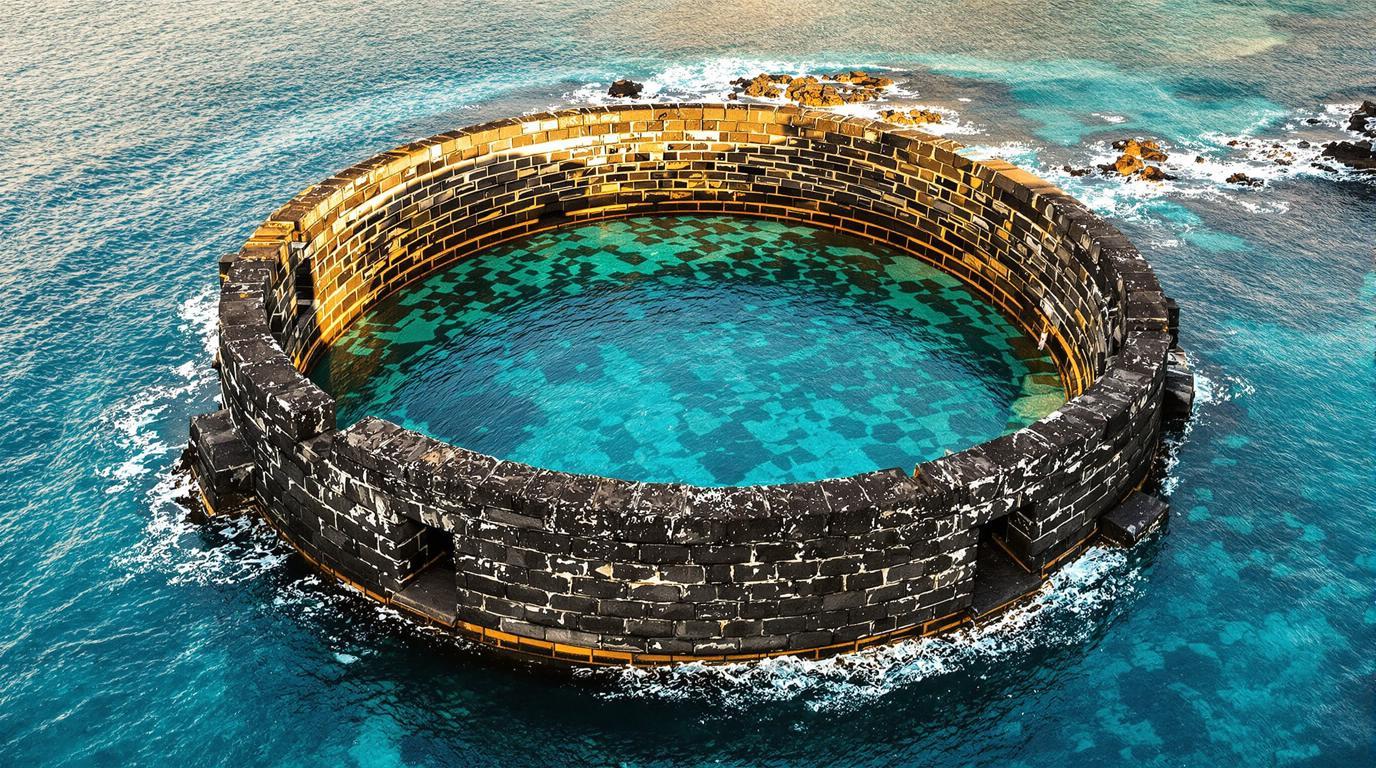The first time I saw the ancient fish traps of Oahu’s North Shore, I nearly dropped my camera. There they were—dark stone crescents emerging from churning Pacific waters like prehistoric monuments, their lava rock walls defying generations of pounding surf. These forgotten remnants of Native Hawaiian ingenuity had survived centuries of colonization, development, and tourism—yet most visitors zoom past them on the Kamehameha Highway, eyes fixed on famous surf breaks like Pipeline and Sunset Beach.
Where ancient Hawaiian innovation meets modern obscurity
These semicircular stone enclosures, known locally as “loko i’a” (fish ponds), represent one of the most sophisticated aquaculture systems ever developed in the Pacific. Dating back over 800 years, these ingenious structures allowed Native Hawaiians to raise fish in controlled environments along the coastline.
“Our kūpuna (ancestors) understood the ocean’s rhythms in ways modern science is still trying to comprehend,” explains Kekoa Kaluhiwa, a local conservationist working to restore several North Shore fish ponds. “They engineered these ponds to work with tidal patterns, creating sustainable food systems that supported large populations without depleting wild fish stocks.”
Today, fewer than 20 of these ancient aquaculture marvels remain intact on Oahu’s North Shore—hidden in plain sight between tourist hotspots and million-dollar beach homes.
Discovering Oahu’s coastal treasures beyond the crowds
The moonlit engineering of Pāhipahiālua fish pond
Near Kawela Bay, a quarter-mile past the famous Turtle Bay Resort, I found the most impressive remaining fish pond structure. Pāhipahiālua spans nearly three acres of coastal waters, its curved stone wall creating a peaceful sanctuary from crashing waves beyond.
Visit at low tide (check local tide tables) when the full architecture reveals itself. Walking the perimeter takes about 20 minutes, with interpretive signs explaining how the sluice gates once worked—letting small fish enter through the mākāhā (gates) during high tide while trapping them as they grew too large to exit.
During monthly community workdays, visitors can join restoration efforts—clearing invasive algae and rebuilding collapsed sections alongside descendants of the original pond keepers.
The sacred springs of Waimea Valley’s hidden pools
Just inland from Waimea Bay lies another marvel most tourists miss. A half-mile hike up a service road (accessible only with permission from valley management) reveals a series of pristine freshwater springs feeding into terraced agricultural pools that once supported taro cultivation and inland fish farming.
Unlike the crowded waterfall pool at the valley’s main attraction, these secluded spring-fed pools remain untouched by commercial tourism. The water runs so clear that you can spot native ‘o’opu (gobies) darting between submerged rocks.
“These upper valley springs are considered wahi pana—sacred places,” whispers cultural practitioner Mālia Craver as we approach. “The waters here connect the mountains to the sea, just as they connected generations of our people.”
Tasting the bounty of ancient Hawaiian aquaculture
To truly understand these fish ponds’ significance, I sought out Waialua Fresh Catch, a modest food truck parked weekends near Haleiwa Town. Here, third-generation fisherman Kainoa Keaulana serves poke bowls featuring mullet and milkfish raised in his family’s restored fish pond—perhaps the only place in Hawaii serving fish cultivated using thousand-year-old methods.
The fish, marinated simply in limu (seaweed), inamona (roasted kukui nut), and Hawaiian sea salt, delivers a clean, mineral-rich flavor entirely different from commercial fish. Paired with poi (fermented taro paste) made from taro grown in adjacent lo’i (wetland fields), it offers a direct taste connection to pre-contact Hawaiian sustainability.
Navigating North Shore’s historical treasures
Timing your exploration
Visit between April and early October when calmer summer seas make the fish pond walls more visible and safer to approach. Winter’s massive North Shore swells can completely submerge the structures.
Respectful access
Many fish ponds sit on private property or require cultural sensitivity. The Mālama Loko I’a program offers guided tours on the first Saturday monthly (reservation required), providing appropriate cultural context and permission.
Supporting restoration
Consider donating to conservation efforts preserving ancient coastal heritage sites like these—whether in Hawaii or elsewhere in the Pacific.
Reflecting on Hawaii’s sustainable past and future
Standing beside these ancient fish ponds as sunset paints the North Shore gold, I’m struck by how relevant their lessons remain. In an era of industrial fishing and depleted oceans, these stone crescents represent indigenous wisdom that sustained Hawaii for centuries before Western contact. Like traditional seaweed farmers in Indonesia or surf preservationists in the Maldives, Hawaii’s fish pond restorers remind us that sometimes the most innovative solutions are the ones our ancestors already perfected.
